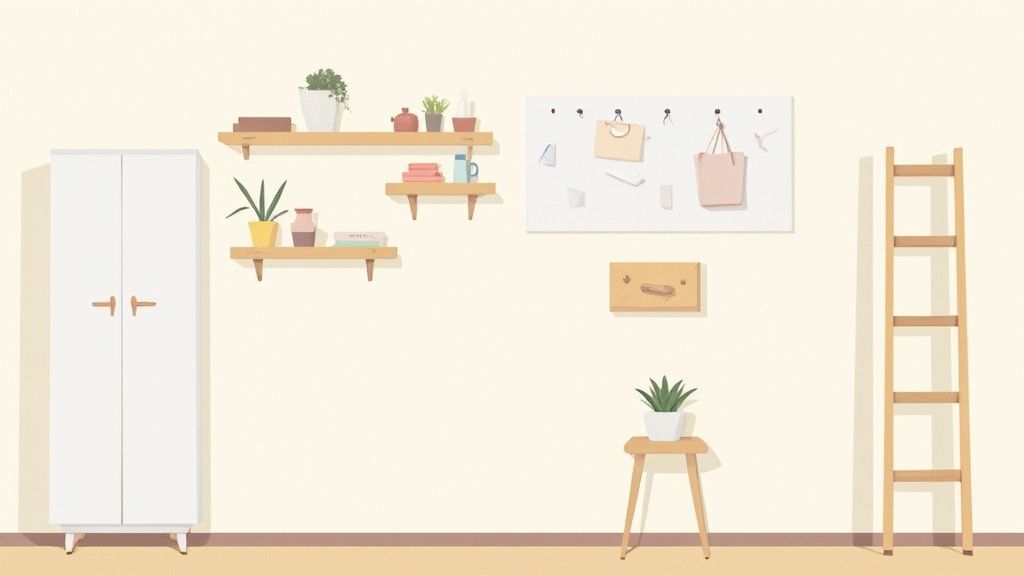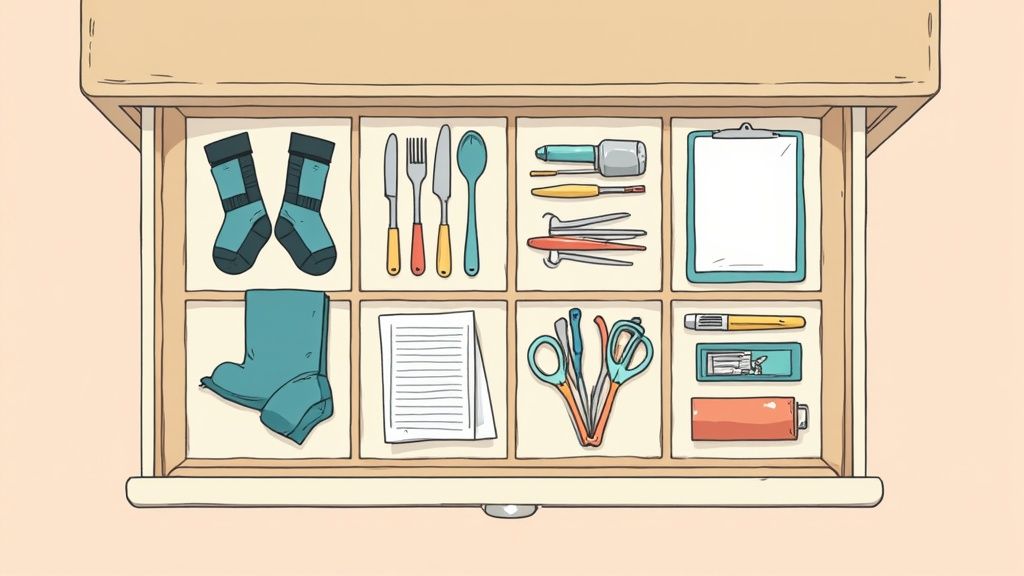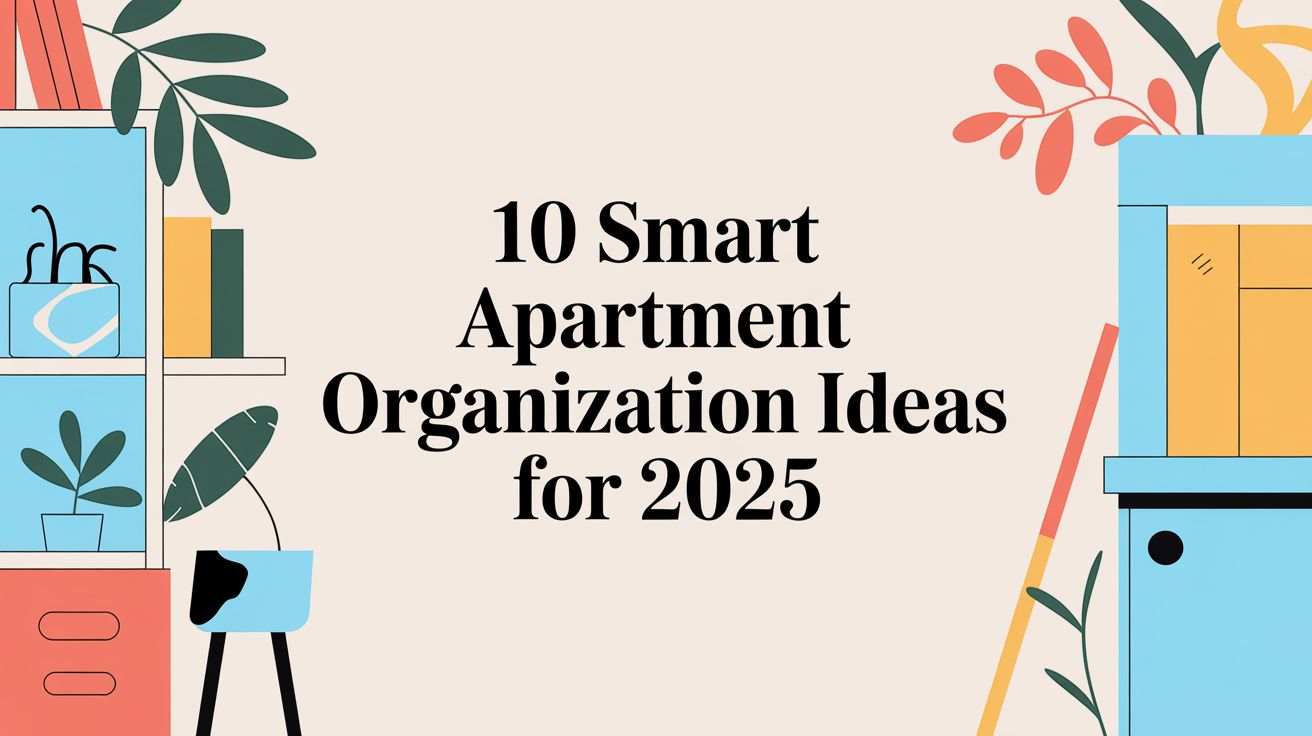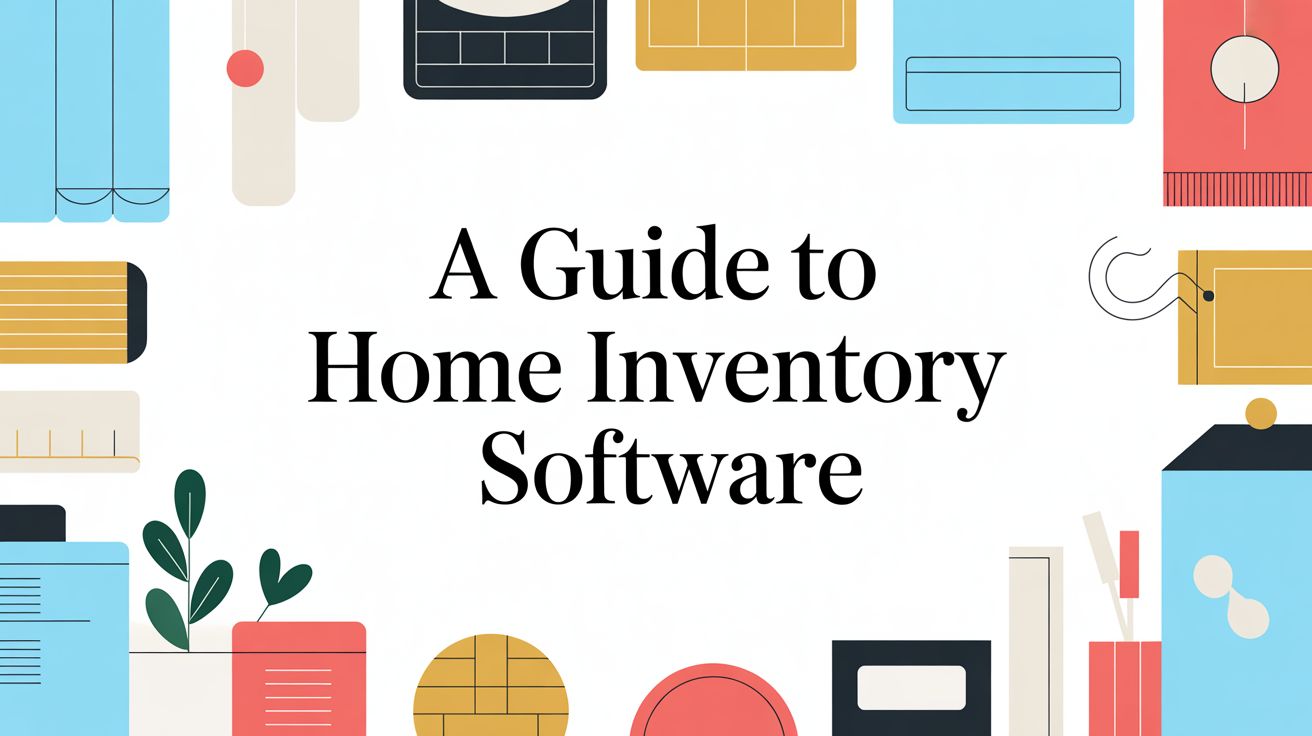Living in an apartment often forces you to make every square foot count. This guide compiles actionable apartment organization ideas to transform cluttered corners into efficient storage zones. You’ll discover room-by-room hacks, renter-friendly setups and digital inventory tools that ensure order and accessibility.
Skipping vague tips, this listicle delivers specific strategies such as decluttering routines, modular shelving and zone-based workflows. Real scenarios illustrate how busy families, frequent movers and collectors can maintain neat environments. We also show how to integrate Vorby’s inventory features to tag, map and locate items instantly.
Whether you are a busy parent juggling kids’ toys, a student moving every semester or a collector curating a growing library, these apartment organization ideas adapt to your lifestyle. You will learn to set up shared workflows for roommates, track warranties and manuals for electronics and maintain a clear overview of possessions. This practical focus helps you stay on top of household tasks and avoid urgent searches.
What you will learn
- How to apply Marie Kondo’s KonMari Method in limited spaces
- Vertical storage systems that free up floor area
- Four-Box Method for fast, effective decluttering
- Renter-safe pegboards, hooks and modular installations
- Under-bed solutions, drawer dividers and closet optimizations
- The one-in-one-out rule for sustainable item management
- Integrating Vorby to label boxes, track warranties and share household workflows
With these actionable apartment organization ideas you’ll reduce daily frustration and reclaim your living space. Each tip pairs practical steps with real-world examples for immediate impact.
Ready to streamline your apartment life? Dive into the strategies below to build a system that works for you.
1. Marie Kondo's KonMari Method
The KonMari Method, created by Japanese organizing consultant Marie Kondo, is less of a simple tidying technique and more of a transformative lifestyle philosophy. Its core principle is beautifully simple: surround yourself only with items that "spark joy." Instead of decluttering room by room, this method tackles your belongings by category, ensuring a comprehensive and mindful purge that prevents clutter from creeping back in. This approach is one of the most effective apartment organization ideas because it fundamentally changes your relationship with your possessions, which is crucial for maintaining order in a smaller space.
How the KonMari Method Works
The process involves gathering all items from a single category into one pile. You then physically hold each item and ask yourself, "Does this spark joy?" If the answer is a clear yes, you keep it. If not, you thank the item for its service and let it go. This emotional connection makes decluttering a grateful and intentional act, not just a chore. The prescribed order is designed to build your decision-making skills:
- Clothing: The easiest category to start with, as our connection to clothes is often less sentimental.
- Books: Forces you to confront which stories and information you truly value.
- Papers: A practical category focused on keeping only what is essential.
- Komono (Miscellaneous): Includes everything from kitchen gadgets to bathroom supplies.
- Sentimental Items: The final and most difficult category, handled once your "spark joy" instincts are fully honed.
Implementing KonMari in Your Apartment
To effectively use this method, commit to finishing one category completely before starting the next. A key visual component is Kondo's signature vertical folding technique for clothing. Folding items into compact rectangles and storing them upright in drawers, like a file cabinet, allows you to see everything at once, preventing forgotten items from getting lost at the bottom of a pile. This technique alone can dramatically increase your storage efficiency. For a deeper dive into similar strategies, you can explore a variety of other home organization hacks that complement the KonMari philosophy.
2. Vertical Storage Solutions
When floor space is at a premium, the only way to go is up. Vertical storage is a foundational principle of small-space living that involves using the height of your walls to create storage, drawing the eye upward and making rooms feel larger and less cluttered. Instead of relying on bulky, floor-hogging furniture, this approach utilizes wall-mounted shelves, tall bookcases, and hanging organizers to reclaim unused vertical real estate. This is one of the most impactful apartment organization ideas because it effectively multiplies your storage capacity without sacrificing precious living area.

How Vertical Storage Works
The core concept is to shift storage from a horizontal plane (the floor) to a vertical one (the walls). This can be achieved through a variety of tools and furniture, from simple floating shelves to complex modular systems like IKEA's KALLAX or BESTA units. The goal is to create designated homes for items that would otherwise clutter surfaces like tables and countertops. By building storage upwards, you not only organize your belongings but also create an illusion of height and spaciousness, a common technique seen in professionally designed micro-apartments.
Implementing Vertical Storage in Your Apartment
To make the most of this strategy, assess each room for unused wall space, particularly above doorways, desks, and toilets. Think about what needs to be stored and choose a solution that fits both the function and the aesthetic of the space. Consider these actionable tips:
- Floating Shelves: Install these at eye level in the kitchen for spices and everyday dishes or in the living room to display decor without a bulky cabinet.
- Pegboards: A versatile, renter-friendly option for home offices, craft areas, or even kitchens to hang tools, supplies, and utensils.
- Tall, Narrow Bookcases: These units draw the eye upward and provide significant storage for books, bins, and baskets while maintaining a small footprint.
- Hanging Organizers: Use over-the-door organizers for shoes in the closet or pocket organizers on a wall to sort mail and small essentials.
By combining these elements, you can create a customized system that keeps your apartment tidy and functional. For more inspiration, you can explore a variety of other stylish storage solutions to declutter your home that build on these vertical principles.
3. The Four-Box Method
The Four-Box Method is a straightforward and highly efficient decluttering technique perfect for those who need to make quick, decisive progress. Unlike philosophical approaches, this method is pure action, forcing you to make an immediate decision about every item you own. It simplifies the often overwhelming task of decluttering into four clear categories: Keep, Donate/Sell, Store, and Trash. This system is one of the most practical apartment organization ideas because it provides a tangible framework that works exceptionally well for tackling one room or even a small closet at a time, preventing decision fatigue.
How the Four-Box Method Works
The process is incredibly simple to start. You will need four large boxes or designated areas, each clearly labeled with one of the action-oriented categories. As you go through your belongings in a specific area, you pick up one item at a time and place it directly into one of the four boxes, with no "maybe" pile allowed. This immediate sorting prevents second-guessing and keeps the momentum going. The categories are:
- Keep: For items you use, love, and have a designated place for in your apartment.
- Donate/Sell: For items in good condition that you no longer need but someone else could use.
- Store: For items you need to keep but don't use regularly, like seasonal decor or important documents.
- Trash/Recycle: For items that are broken, expired, or no longer usable.
Implementing the Four-Box Method in Your Apartment
To make this method successful in a smaller space, focus on one contained area at a time, such as a single bookshelf, a kitchen cabinet, or your entryway closet. Set a timer for 20-30 minutes to create a sense of urgency and maintain focus. A crucial tip is to process the boxes immediately after the sorting session is complete. Put the trash out, place the donation box in your car for its next trip, and put the "Keep" items back in their newly organized homes right away. This immediate follow-through provides instant gratification and prevents sorted clutter from becoming a new mess.
4. Modular Storage Systems
Modular storage systems are the ultimate solution for renters and apartment dwellers facing ever-changing spatial needs. Unlike traditional, fixed furniture, these systems consist of interchangeable components like shelves, drawers, bins, and frames that can be combined and reconfigured to fit your exact space and storage requirements. This adaptability makes them one of the most practical apartment organization ideas, allowing your storage to evolve with you as your belongings or living situation changes. Popular systems like IKEA's KALLAX or The Container Store's Elfa offer endless customization, ensuring no square foot goes to waste.
How Modular Storage Systems Work
The core concept is flexibility. You start with a basic frame or track system and then add the components you need, creating a personalized unit for anything from clothing to craft supplies. If you move to a new apartment with different wall dimensions or need to repurpose a unit from a home office to a nursery, you can simply reconfigure the existing pieces or add new ones. This build-as-you-go approach is both cost-effective and sustainable, preventing the need to buy entirely new furniture.
The most common modular components include:
- Grid or Cube Units: Like the IKEA KALLAX, these offer simple, stackable cubes that can be filled with drawers, doors, or fabric bins.
- Track-Based Wall Systems: Elfa is a prime example, using vertical tracks mounted to the wall where shelves and drawers can be clipped in at any height.
- Customizable Wardrobe Systems: IKEA's PAX system lets you design a closet interior from scratch, choosing the precise number of shelves, hanging rods, and drawers you need.
Implementing Modular Storage in Your Apartment
To make the most of a modular system, start by carefully measuring the space you intend to use. Most brands, such as those at The Container Store, offer online planning tools to help you visualize the final setup. Begin with a starter unit to see how it functions in your home before committing to a larger configuration. For a clean, cohesive look, use matching bins and containers within the unit and label everything clearly. This not only enhances visual harmony but also makes finding items quick and effortless.
5. Zone-Based Organization
Zone-based organization is a strategic approach, often used by interior designers for small spaces, that involves dividing your apartment into distinct functional areas. The core principle is to group all items and activities related to a specific purpose into a designated "zone," creating a logical and efficient workflow. Instead of thinking in terms of rooms, you think in terms of activities, which is one of the most practical apartment organization ideas for studio apartments or open-concept layouts where traditional room boundaries don't exist. This method prevents clutter from migrating across your home by giving every item a clear functional home.
How Zone-Based Organization Works
The process starts by mapping out the primary activities you perform in your apartment, such as working, sleeping, cooking, or relaxing. You then assign a physical area to each activity and furnish it accordingly, ensuring everything needed for that task is within arm's reach. This creates self-contained ecosystems that make daily routines seamless and keep unrelated items from piling up. Common zones in a small apartment might include:
- Work Zone: A desk, comfortable chair, and storage for all office supplies.
- Relaxation Zone: An armchair, a side table for drinks, and a basket for blankets or books.
- Cooking Zone: Divided further into stations for prep, cooking, and cleaning.
- Sleeping Zone: A bed, nightstand, and minimal decor to promote rest.
Implementing Zoning in Your Apartment
To effectively implement this method, use visual cues to delineate each zone. Area rugs are perfect for anchoring a living or relaxation zone, while a strategically placed bookshelf can create a subtle-yet-effective barrier for a home office nook. The key is to be disciplined about keeping items within their designated areas; for example, work documents should never end up in the relaxation zone. This approach not only organizes your physical belongings but also mentally separates different aspects of your life, which is especially valuable when your living room also serves as your office. For more inspiration on defining small spaces, many design blogs like Apartment Therapy offer excellent visual guides.
6. Under-Bed Storage Solutions
Utilizing the space beneath your bed is one of the most classic yet effective apartment organization ideas, transforming a typically dusty, forgotten area into prime real estate for storage. This strategy is essential for anyone living in a small apartment, dorm room, or any space where floor area is a precious commodity. Instead of letting this valuable zone go to waste, you can employ a range of containers and tools to reclaim it for seasonal items, extra linens, or anything you don't need daily access to.

How Under-Bed Storage Works
The concept is simple: use the horizontal space under your bed frame for low-profile storage. This can be accomplished with specifically designed containers that fit the clearance or by physically lifting the bed to create more vertical room. The goal is to keep items organized, protected from dust, and easily accessible without cluttering your main living areas. This method is perfect for things you need to keep but don't use frequently, such as holiday decorations, out-of-season clothing, or guest bedding.
- Containers: Low-profile bins, often made of plastic or fabric, are designed to slide easily under most standard bed frames. Many come with wheels for effortless access.
- Bed Risers: These simple, sturdy blocks are placed under each leg of the bed frame to elevate it, instantly creating several extra inches of vertical storage space.
- Vacuum-Sealed Bags: Ideal for bulky items like comforters and winter coats, these bags compress contents down to a fraction of their original size, allowing you to fit more into each container.
- DIY Solutions: Simple wooden boxes with casters or repurposed drawers can also serve as effective and customized under-bed storage units.
Implementing Under-Bed Storage in Your Apartment
First, measure the clearance from the floor to your bed frame to determine what size containers will fit. If you need more height, bed risers are an inexpensive and immediate solution. Choose clear containers when possible, so you can see the contents at a glance without having to pull everything out. To maximize efficiency, group similar items together; for example, dedicate one bin for winter sweaters and another for spare towels and sheets. Labeling each container clearly will save you time and frustration later. To get more inspiration, you can learn more about making hidden storage look good and seamlessly integrating it into your decor.
7. The One-In-One-Out Rule
The One-In-One-Out Rule is a simple yet powerful maintenance principle designed to prevent clutter from accumulating over time. Its core concept is straightforward: for every new item you bring into your apartment, an equivalent item must be removed. This transforms organization from a one-time, monumental task into an ongoing, manageable habit. This approach is one of the most sustainable apartment organization ideas because it directly combats the root cause of clutter, which is mindless acquisition, ensuring your space remains balanced and tidy long-term.
How the One-In-One-Out Rule Works
This rule forces you to critically evaluate every purchase and gift you receive. Before bringing a new pair of shoes home, you must decide which old pair will leave. This conscious trade-off prevents impulse buys and the slow creep of excess possessions. It works best when applied consistently across different categories, creating a steady state of organization rather than a cycle of decluttering and re-cluttering. This philosophy is particularly effective for:
- Clothing: Popularized by capsule wardrobe enthusiasts, it keeps closets curated and functional.
- Books: Encourages you to pass on books you've read to make room for new stories.
- Kitchen Gadgets: Prevents drawers and cabinets from overflowing with single-use tools.
- Decor: Ensures your decor feels fresh and intentional, not just accumulated.
- Children's Toys: Helps manage the constant influx of new toys from birthdays and holidays.
Implementing One-In-One-Out in Your Apartment
To successfully adopt this rule, make the "out" process as easy as possible. Keep a designated donation box in a convenient spot, like a closet or near the front door. When you bring something new in, immediately select the item it's replacing and place it in the box. To make this habit stick, set clear guidelines for yourself before shopping trips. For example, if you're buying a new coffee mug, you must choose one to donate before the new one can be put away. This small, consistent action is the key to maintaining a clutter-free apartment without feeling deprived.
8. Drawer Dividers and Compartmentalization
Compartmentalization is the practice of using drawer dividers to create dedicated, organized sections for your belongings. Instead of letting items slide into a jumbled mess, this technique establishes order by assigning a specific home for everything from kitchen utensils to office supplies. This simple yet powerful strategy is one of the most effective apartment organization ideas because it maximizes the utility of hidden storage spaces like drawers and cabinets, making items instantly visible and accessible. It transforms chaotic catch-all spaces into models of efficiency.

How Drawer Compartmentalization Works
The concept is straightforward: you insert physical barriers inside a drawer to create smaller, purpose-built compartments. This prevents items from shifting and mixing, which is especially helpful for small objects. By grouping similar items together, you eliminate the need to rummage through clutter, saving time and reducing stress. The key is to customize the layout to fit the specific items you store, whether it's separating forks from knives or pens from paper clips. This approach brings a satisfying sense of order to previously unruly areas.
Common applications include:
- Kitchen "Junk" Drawer: Tame the chaos by creating spots for batteries, tape, and miscellaneous tools.
- Bedroom Dresser: Separate socks, underwear, and accessories for a clear and manageable wardrobe.
- Office Desk: Organize pens, sticky notes, and cables for a more productive workspace.
- Bathroom Vanity: Keep makeup, toiletries, and first-aid supplies neatly sorted and easy to find.
Implementing Dividers in Your Apartment
To get started, first empty and clean the drawer, then measure its interior dimensions. This step is crucial for purchasing dividers that fit correctly. Adjustable dividers, often made from bamboo or plastic, offer excellent flexibility and can be reconfigured as your storage needs change. When arranging the compartments, think about how you use the items. Place frequently used objects in the most accessible front sections. For an even more streamlined system, you can label each section, which is particularly helpful in shared living spaces.
9. Wall-Mounted Pegboards and Hook Systems
Wall-mounted pegboards offer a highly versatile and visually appealing vertical storage solution, transforming unused wall space into a functional organization hub. This system uses a perforated board that accepts a wide variety of hooks, shelves, and baskets, allowing you to create a completely customized layout for your belongings. Because it keeps items off countertops and floors, it's one of the most effective apartment organization ideas for maximizing square footage in kitchens, home offices, and entryways. The genius of the pegboard is its adaptability; you can rearrange it in minutes as your needs change.
How Pegboard Systems Work
The core of the system is the pegboard itself, which is mounted directly to a wall. Once installed, you can insert various accessories into the holes to hold specific items. This modularity allows you to create a designated spot for everything, from kitchen utensils and craft supplies to office stationery and everyday essentials like keys and mail. This approach keeps frequently used items visible and within arm's reach, streamlining daily routines and eliminating the need to rummage through drawers.
- Kitchen: Organize pots, pans, measuring cups, and utensils for easy access while cooking.
- Home Office: Create a command center for pens, scissors, documents, and tech accessories.
- Craft Room: Display threads, tools, and paints, turning supplies into part of the decor.
- Entryway: Design a drop zone for keys, bags, hats, and outgoing mail.
Implementing Pegboards in Your Apartment
To get the most out of a pegboard system, start by grouping related items you want to store together. Plan your layout before inserting hooks to ensure an efficient and balanced look. For a cohesive aesthetic, use matching hooks and containers. Remember to leave some negative space on the board to prevent it from looking cluttered and overwhelming. For renters, many brands offer damage-free installation options using strong adhesive strips, making this a perfect temporary and renter-friendly organization solution. Systems like the IKEA SKÅDIS series have popularized this method, offering an accessible and stylish entry point into vertical organization.
10. Closet Organization Systems (Vertical Hanging and Shelving)
A well-designed closet organization system transforms a chaotic space into a functional, streamlined storage hub. Instead of a single rod and a high shelf, this approach utilizes a combination of vertical hanging rods, adjustable shelving, and modular components to maximize every square inch of your closet. It's one of the most impactful apartment organization ideas because it doubles, or even triples, your storage capacity without requiring more floor space. Systems popularized by brands like IKEA and The Container Store make it possible to customize a solution for any closet size or budget.
How Closet Organization Systems Work
The core principle is to strategically divide the closet into dedicated zones based on what you need to store. This is achieved by installing components that cater to different types of items, from long coats to folded sweaters and shoes. By thinking vertically, you reclaim a vast amount of unused space, making everything visible and easily accessible. A typical system might combine several key elements:
- Double Hanging Rods: Installing a second rod below the primary one instantly doubles the hanging space for shorter items like shirts, skirts, and folded pants.
- Vertical Shelving Units: A tower of shelves creates designated spots for folded clothes, bins, and accessories, preventing stacks from toppling over.
- Shelf Dividers: These simple additions keep piles of sweaters or stacks of purses neat and separated on a single shelf.
- Hanging Organizers: Fabric organizers with multiple compartments are perfect for storing shoes, bags, or accessories without taking up shelf space.
Implementing a Closet System in Your Apartment
First, empty your closet completely and assess your inventory. This helps you decide the right mix of hanging space versus shelving. For a renter-friendly option, consider freestanding closet systems or tension rods that don't require drilling into the walls. To create a clean, uniform look that also saves space, switch to slim, matching hangers; this small change prevents clothes from snagging and allows you to fit more items on the rod. Finally, organize clothing by type (e.g., all shirts together) and then by color. This not only looks aesthetically pleasing but also makes finding specific pieces effortless during your morning routine.
10 Apartment Organization Ideas Compared
| Method | 🔄 Implementation Complexity | ⚡ Resources (cost / time / space) | 📊 Expected Outcomes (⭐ effectiveness) | ⭐ Key Advantages | 💡 Quick Tip |
|---|---|---|---|---|---|
| Marie Kondo's KonMari Method | High, multi‑pass, technique learning | Low monetary cost; high time (3–6 months) | ⭐⭐⭐⭐, lasting habits, significant space freed | Encourages mindful decisions; durable order | Start with clothing; hold each item to test "joy" |
| Vertical Storage Solutions | Medium, mounting and layout planning | $50–$500+; moderate install time; uses wall height | ⭐⭐⭐⭐, maximizes floor space; visually expansive | Efficient use of vertical real estate; customizable | Place floating shelves at eye level; use baskets to hide clutter |
| The Four‑Box Method | Low, simple, decision‑based process | Minimal cost; fast (1–2 hrs/room) | ⭐⭐⭐, rapid declutter; immediate volume reduction | Quick, decisive sorting; generates donations/sales | Set a timer and schedule donation/sale pickup immediately |
| Modular Storage Systems | Medium–High, planning + assembly | $200–$2000+; upfront time to design | ⭐⭐⭐⭐, scalable, long‑term organized systems | Reconfigurable, grows with needs; professional look | Measure carefully; start with one unit to test layout |
| Zone‑Based Organization | Medium, requires spatial planning | Varies; needs adequate floor area (best 400+ sq ft) | ⭐⭐⭐⭐, improved workflow; less mental clutter | Activity‑based efficiency; easier to find items | Define zone purposes before furnishing; use rugs to delineate |
| Under‑Bed Storage Solutions | Low, simple implementation | $30–$200; constrained by bed height; low install time | ⭐⭐⭐, good hidden capacity; best for infrequent items | Utilizes wasted space; affordable and out of sight | Use clear rolling bins and moisture absorbers; store seasonal items |
| The One‑In‑One‑Out Rule | Low, ongoing behavioral practice | Minimal cost; lifetime habit required | ⭐⭐⭐, prevents accumulation if consistently applied | Maintains order; promotes mindful consumption | Keep a donation box handy and track new purchases |
| Drawer Dividers & Compartmentalization | Low–Medium, measuring and fitting | $15–$100 per drawer; setup time per drawer | ⭐⭐⭐⭐, improves daily efficiency and visibility | Prevents shifting; maximizes drawer use | Measure drawers first; use adjustable/bamboo dividers |
| Wall‑Mounted Pegboards & Hook Systems | Medium, install and layout choices | $40–$150; may require drilling or adhesive options | ⭐⭐⭐⭐, visible, accessible tools and supplies | Highly customizable; clears counters and surfaces | Group related items and take a photo before rearranging |
| Closet Organization Systems (hanging & shelving) | Medium–High, installation or pro service | $200–$3000+; planning and installation time | ⭐⭐⭐⭐, greatly increases closet capacity & visibility | Optimizes garment care and daily routines | Use matching hangers, add double rods and shelf dividers |
From Ideas to Action: Creating Your Organized Oasis
Embarking on a quest for better organization is one of the most transformative projects you can undertake for your living space. Throughout this guide, we have explored a comprehensive toolkit of apartment organization ideas, from the philosophical approach of the KonMari Method to the practical genius of vertical storage solutions. Each strategy, whether it’s the decisive Four-Box Method for decluttering or the adaptable nature of modular shelving, offers a unique pathway to a clearer, more functional home. We have seen how simple additions, like drawer dividers and wall-mounted pegboards, can reclaim lost space and bring order to chaos.
The journey from a cluttered apartment to a curated sanctuary is built on these foundational principles. It’s about more than just finding a place for everything; it's about creating systems that work for you, not against you. The One-In-One-Out Rule instills a lasting habit of mindfulness, preventing the slow creep of clutter. Zone-based organization transforms your home into an intuitive map, where every item has a logical and designated place. These aren't just one-time fixes; they are sustainable practices that cultivate a lasting sense of peace and control.
Bridging the Physical and Digital Worlds
The true masterstroke in modern home organization lies in integrating these physical systems with smart digital tools. You can perfectly categorize your belongings, but if you can't remember which under-bed bin holds your hiking gear or which closet shelf stores the extra linens, the system's efficiency is compromised. This is the critical gap where a home inventory service becomes not just a luxury, but an essential component of your organizational strategy.
Key Insight: A truly organized space is one where you can find anything you own in seconds. This requires not only a physical system for storage but also a digital system for retrieval.
Imagine this scenario: you've meticulously labeled every box in your storage closet. Six months later, you need a specific cable for a device. Instead of opening every box, you could simply search a digital inventory, pinpointing its exact location instantly. By pairing QR codes or NFC tags with your bins, shelves, and containers, you create a searchable, digital twin of your physical space. This powerful combination elevates your organization from static to dynamic, making maintenance effortless and retrieval instantaneous.
Your Action Plan for Lasting Organization
The wealth of apartment organization ideas presented here can feel overwhelming, but the key is to start small and build momentum. Don't try to overhaul your entire apartment in a single weekend. Instead, choose one area that causes you the most daily friction, perhaps a messy entryway or a chaotic kitchen drawer, and apply one of the methods we've discussed.
- Select Your Starting Point: Pick a small, manageable area like your nightstand, a single bookshelf, or the "junk drawer."
- Choose Your Method: Decide which strategy resonates most. Do you need the decisive cut of the Four-Box Method, or the detailed compartmentalization offered by drawer dividers?
- Implement and Document: Put the plan into action. As you organize, consider creating a digital record of where important items now live. This small step pays huge dividends later.
- Expand and Refine: Once you experience the success of organizing one small space, use that momentum to tackle the next. Your confidence will grow with each completed project.
Ultimately, mastering apartment organization is about creating a space that serves and supports your life, reducing daily stress and freeing up mental energy for what truly matters. It’s about crafting a peaceful oasis that you are genuinely happy to come home to. The right combination of physical strategies and smart technology makes this goal more achievable than ever. Your serene, impeccably organized home is not a distant dream; it's a series of small, intentional actions away.
Ready to take your organization to the next level? Vorby helps you create a smart digital inventory of your home, so you can find anything in seconds using simple QR codes. Stop guessing where things are and start living in a seamlessly organized space by visiting Vorby today.



